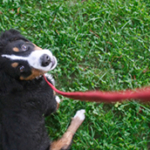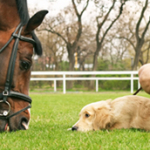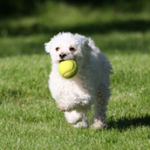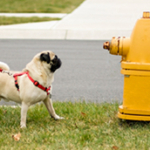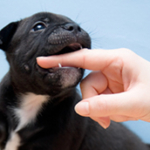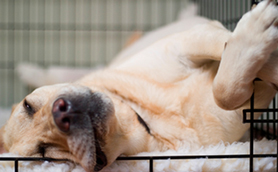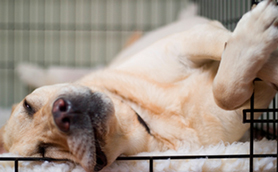 Crate training is a wonderful aid for a variety of reasons. It’s helpful for short-term confinement of your dog (up to 4 hours max) when you can’t supervise him. If he’s in his safe, quiet crate relaxing with a stuffed Kong®/chewie, he won’t be practicing “inappropriate” behavior – like chewing on the wrong things, having potty mistakes, barking at windows, etc. Crates can also make traveling a safer experience for driver and dog. In addition, crates are a good option if your dog is wound up and over-stimulated. Sometimes dogs just need a break (and so might you)!
Crate training is a wonderful aid for a variety of reasons. It’s helpful for short-term confinement of your dog (up to 4 hours max) when you can’t supervise him. If he’s in his safe, quiet crate relaxing with a stuffed Kong®/chewie, he won’t be practicing “inappropriate” behavior – like chewing on the wrong things, having potty mistakes, barking at windows, etc. Crates can also make traveling a safer experience for driver and dog. In addition, crates are a good option if your dog is wound up and over-stimulated. Sometimes dogs just need a break (and so might you)!
Size & variety
There are many different types of crates to choose from. Some are made of tough plastic, others are made of metal. Plastic crates are lighter weight and are easier to transport. Exercise pens (made of metal) are another option for confining your dog. Exercise pens are similar to a playpen and you can adjust the shape and/or size accordingly. If your dog is a jumper, you might want to consider purchasing a lid for the pen, or just use a crate instead. If you are house training your dog, make sure your dog doesn’t have enough room to sleep on one side and potty on the other. Remember, dogs have a natural instinct to keep their bed clean. The crate should have enough space for your dog to comfortably stand, turn around, and lie down. If you want to save money in the long run, buy a crate for your dog to grow into and block part of it off to make the space smaller. This will help prevent potty accidents from occurring inside the crate.
Introducing the crate
Introduce your dog to the crate in a positive, upbeat way. Leave the crate door open and toss in delicious snacks for your dog. When your dog goes in to eat the treats, praise and continue to drop snacks into the crate while your dog remains inside. Keep these initial training sessions short. You can also feed your dog his meals in the crate. Once your dog is willingly going into his crate, stuff a Kong® toy or get an exciting chewie, show it to your dog, toss it into the crate, and then shut the door (with your dog still on the outside). Hopefully your dog will be dying to get into his crate. Open the door, allow the dog in and while he’s happily chewing shut the crate door. Open the door while your dog is still enjoying his toy and give him the opportunity to come out. With each training session, see if you can extend the amount of time the door remains shut. After some positive training sessions, your dog should start to look forward to crate time. If, however, your dog starts to complain (bark, whine, etc), ignore the behavior and wait until he is quiet for a few seconds before you let him out. If you open the crate door when he’s loud, he’ll learn complaining is an effective strategy to gain freedom and will probably be louder and more persistent in the future. If you encounter problems or have questions, please contact your trainer.




